

Marks and Spencer PESTEL and SWOT analysis by Anna Prokhorova on Prezi. Sign In/Create Account. American Apparel Business Plan. Competitors and Market Share - AMERICAN APPAREL INC. Customer Profile of American Apparel. As the name suggests, American Apparel is based out of the United States where all of its products are designed and manufactured in its Los Angeles factory.
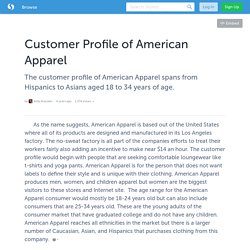
The no-sweat factory is all part of the companies efforts to treat their workers fairly also adding an incentive to make near $14 an hour. The customer profile would begin with people that are seeking comfortable loungewear like t-shirts and yoga pants. American Apparel is for the person that does not want labels to define their style and is unique with their clothing. American Apparel produces men, women, and children apparel but women are the biggest visitors to these stores and Internet site. History of American Apparel. A brief history of American Apparel. American Apparel was not necessarily destined for greatness when its founder – then just a high-schooler – had an idea: he would sell t-shirts.
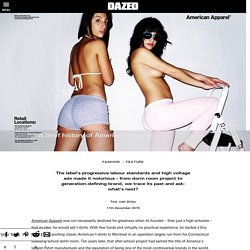
With few funds and virtually no practical experience, he started a tiny business, importing classic American t-shirts to Montreal in an operation largely run from his Connecticut boarding school dorm room. Ten years later, that after-school project had earned the title of America’s largest t-shirt manufacturer and the reputation of being one of the most controversial brands in the world. How did that happen? To answer that, you have to familiarise yourself with Dov Charney, the brand’s founder and its biggest liability.
In the early 1990s American Apparel was just a small start-up established by the Canadian Charney, who had enrolled at Tufts University near Boston only to drop out before graduation to pursue the endeavour full-time with money borrowed from his parents. These were not women you would see walking during Paris Fashion Week. Back From the Brink: American Apparel Ramps Up Marketing. American Apparel, the brand that birthed a fashion revolution of leggings and crop tops before unraveling into a sleazy spectacle, is moving beyond bankruptcy and attempting a fresh beginning.

After exiting Chapter 11 last week, the Los Angeles-based company is rolling out new marketing for spring to reestablish its reputation with consumers. "This is the first year we have a true marketing budget and financials in place to employ a marketing strategy," said Cynthia Erland, senior VP-marketing, who joined the brand last year. American Apparel hopes to have a marketing budget of around $500,000, though that figure is still subject to approval. American Apparel’s banned ads are a shocking example of marketing. The latest American Apparel ad to be banned shows a young woman leaning through the window of a car, showing her underwear to camera.

I say latest because it’s the most recent in a long line of American Apparel ads to have met with the same fate. This time the Advertising Standards Agency (ASA) said: “We considered the ads had the effect of inappropriately sexualising school-age girls and were therefore offensive and irresponsible for that reason too.” If they hadn’t been banned for bad taste they should have been banned for bad marketing. American Apparel could start closing UK stores. One of American Apparel’s flagship stores, in London’s Covent Garden, could be closed along with four other UK shops.
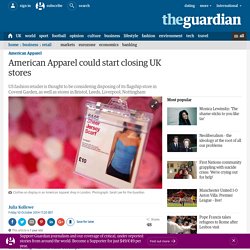
The embattled US fashion retailer is thought to be considering disposing of its shops in Bristol, Leeds, Liverpool, Nottingham and the store on Neal Street in Covent Garden and has appointed UK retail property specialist Kitchen La Frenais Morgan, Property Week reported (£). This would leave the chain, which became known for its Made in the USA clothes, as well as its controversial ads, with four stores outside London – in Brighton, Birmingham, Glasgow and Manchester. The Los Angeles-based retailer is expected to hold on to its other nine stores in London, alongside a concession in department store Selfridges. The rise and fall of American Apparel. It wasn't having oral sex with an employee in front of a female journalist that now threatens to undo Dov Charney, founder of American Apparel.

Nor was it simulating oral sex with another female member of staff whom he had ordered to pretend to masturbate in front of him. The 41-year-old's professional and personal reputation isn't even on the line because at least three female employees have filed sexual harassment lawsuits against him (all the cases were settled before reaching trial); nor because he walks through his factory in his underpants and conducts meetings wearing just a thong – or a sock. The sock is not, one should add, worn on his foot. For the exhibitionist Charney, whose excesses are the stuff of fashion-industry legend, to be finally humbled by accounts that are more street corner than Wall Street is, some might think, a bit like Al Capone finally being brought to book over tax evasion. But whatever the catalyst, it has led to the unravelling of an empire. Competitor’s analysis. American Apparel does business in an exceptionally competitive landscape.
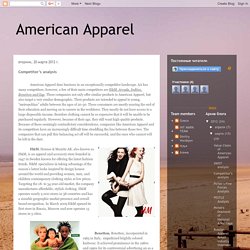
AA has many competitors; however, a few of their main competitors are H&M, Arcada, Inditex, Benetton and Gap. These companies not only offer similar products to American Apparel, but also target a very similar demographic. Their products are intended to appeal to young, “metropolitan” adults between the ages of 20-30. These consumers are mostly nearing the end of their education and moving on to careers in the workforce. They mostly do not have access to a large disposable income, therefore clothing cannot be so expensive that it will be unable to be purchased regularly. H&M. Benetton. Fashionable Basics. Sweatshop Free. Made in USA. American Apparel - Body Confidential - American Apparel. The only thing going for American Apparel was its controversial advertising.
It’s no surprise that American Apparel is on the brink of filing for bankruptcy – just that it has taken this long.

After posting less than pleasing second quarter sales figures – which saw a 17.2% drop over the past year – it’s hard to see how the retailer will come back. And trimming $30 million from its spending – as it plans to do – will be no small feat. What was always a fad brand and product lifecycle has been exacerbated by the character of the founder American Apparel has put on a pretty poor show in recent years. The product, merchandising, design and retail are all hugely unimpressive. American Apparel. Fashionable Basics. Sweatshop Free. Made in USA. Shipping Options. Men's Best Sellers. Designed, Cut and Sewn in Los Angeles. Wholesale T-Shirts. UNiDAYS Student Discount.
American Apparel to open London flagship. American Apparel SS16 Campaign. March 24th, 2016 Provocative basics at their very best.
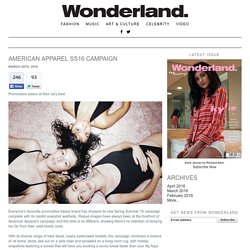
Everyone’s favourite provocative basics brand has dropped its new Spring Summer 16 campaign complete with its candid snapshot aesthetic. Risqué images have always been at the forefront of American Apparel’s campaign and this time is no different, showing there’s no intention of straying too far from their (well-loved) roots. With its diverse range of bare faced, bushy eyebrowed models, the campaign combines a mixture of ‘at home’ shots, laid out on a sofa chair and sprawled on a living room rug, with holiday snapshots featuring a sunset that will have you booking a sunny break faster than your flip flops can take you.
Of course, the campaign isn’t short of skin (and who would want it to be?!) Words: Francesca Lee. American Apparel Shutters Its Bargain-Happy Flea Market, Could Outsource Denim. Following a blink-and-you-missed-it blowout, American Apparel has shuttered its DTLA Factory Flea Market.
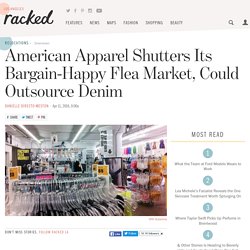
The LA-based label revealed the news on its Facebook page earlier last month, and we're guessing it's part of that downsizing plan, which was expected to happen by March 31st. However, there are still $2 denim deals in LA's future: the outlet store is expected to relocate, but no word yet on the exact coordinates; we've reached out to the brand for more deets.
The major markdowns happening across all of AA's stores are part of it's efforts to "sell off [excess inventory]," which has been among AA's issues, WWD reports. The trade pub also revealed that the basics giant is undergoing yet another round of layoffs (yikes). In addition, WWD notes that the label "will also consider outsourcing more complicated garments, including denim. " Designed, Cut and Sewn in Los Angeles. South Central LA is next cool spot in the sights of American Apparel founder Dov Charney. When American Apparel moved to its Downtown Los Angeles headquarters in 2000, the historic core of America’s second-largest city was still a shabby archetype of urban decay. But in the time it took the clothing manufacturer to grow from a modest wholesale business into a global hipster behemoth, much of Downtown was revitalised, gentrified and transformed back into LA’s beating heart.
Now, the company’s controversial founder, Dov Charney, has made the grand claim that he was personally responsible for the area’s rehabilitation, as he outlined his ambitions for a new clothing business, which he intends to locate in another long-neglected neighbourhood: South Central LA. “Downtown LA, I made it cool,” the Canadian-born entrepreneur said last week, in an interview with PBS host Tavis Smiley. But since he can no longer afford the rejuvenated real estate prices there, he went on, “The next place I intend to make cool is south of the 10 freeway, right on the banks of Downtown.”